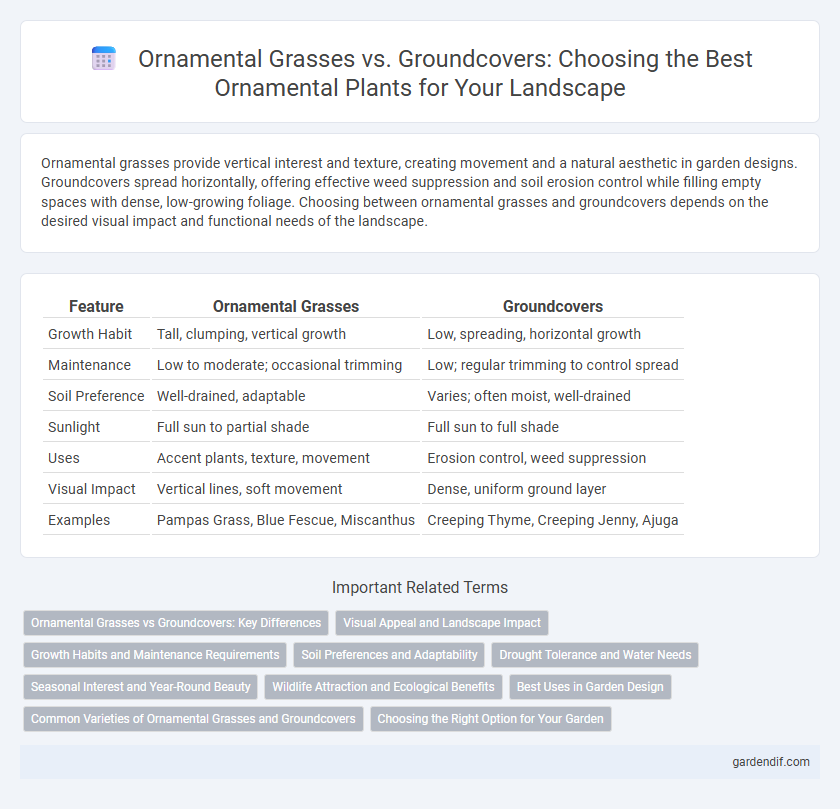
Ornamental Grasses vs Groundcovers Illustration
Ornamental grasses provide vertical interest and texture, creating movement and a natural aesthetic in garden designs. Groundcovers spread horizontally, offering effective weed suppression and soil erosion control while filling empty spaces with dense, low-growing foliage. Choosing between ornamental grasses and groundcovers depends on the desired visual impact and functional needs of the landscape.
Table of Comparison
| Feature | Ornamental Grasses | Groundcovers |
|---|---|---|
| Growth Habit | Tall, clumping, vertical growth | Low, spreading, horizontal growth |
| Maintenance | Low to moderate; occasional trimming | Low; regular trimming to control spread |
| Soil Preference | Well-drained, adaptable | Varies; often moist, well-drained |
| Sunlight | Full sun to partial shade | Full sun to full shade |
| Uses | Accent plants, texture, movement | Erosion control, weed suppression |
| Visual Impact | Vertical lines, soft movement | Dense, uniform ground layer |
| Examples | Pampas Grass, Blue Fescue, Miscanthus | Creeping Thyme, Creeping Jenny, Ajuga |
Ornamental Grasses vs Groundcovers: Key Differences
Ornamental grasses offer vertical texture and movement, often growing taller and providing visual interest through blades and seed heads, while groundcovers create dense, low-growing mats that suppress weeds and stabilize soil. Unlike groundcovers, which primarily serve to fill space and reduce erosion, ornamental grasses are prized for their architectural form and seasonal color changes. The key differences lie in their growth habits, functional roles in landscaping, and aesthetic contributions to garden design.
Visual Appeal and Landscape Impact
Ornamental grasses offer vertical texture and dynamic movement that create focal points and enhance landscape depth, while groundcovers provide uniform, low-growing coverage that suppresses weeds and reduces soil erosion. The contrasting forms between upright grasses and sprawling groundcovers contribute to layered visual interest and balanced garden composition. Selecting the right combination amplifies color variation, seasonal shifts, and overall aesthetic impact in outdoor spaces.
Growth Habits and Maintenance Requirements
Ornamental grasses typically exhibit upright, clumping or arching growth habits, providing vertical interest and texture in garden landscapes, while groundcovers spread horizontally to create dense, low-maintenance mats that suppress weeds and reduce soil erosion. Maintenance for ornamental grasses involves periodic cutting back to remove dead foliage and promote healthy growth, whereas groundcovers require minimal pruning but benefit from occasional thinning to prevent overcrowding. Choosing between the two depends on desired landscape effect, growth rate, and tolerance for routine upkeep tasks.
Soil Preferences and Adaptability
Ornamental grasses thrive in well-drained soils with moderate fertility, showing high adaptability to a range of soil types from sandy to loamy, while preferring full sun to partial shade. Groundcovers generally favor moist, fertile soils with good organic content and often tolerate heavier, clay-rich soils better than grasses. Both plant types contribute to erosion control, but selecting the right species based on soil texture and moisture availability maximizes landscape resilience and aesthetic appeal.
Drought Tolerance and Water Needs
Ornamental grasses typically exhibit high drought tolerance, thriving in arid conditions with minimal irrigation due to their deep root systems. In contrast, groundcovers often require more consistent moisture to maintain their dense foliage and prevent soil erosion. Selecting drought-tolerant species like Blue Fescue or Purple Sage as ornamental grasses reduces water consumption while offering aesthetic texture, whereas groundcovers such as creeping thyme or sedum may need supplemental watering during prolonged dry spells.
Seasonal Interest and Year-Round Beauty
Ornamental grasses provide dynamic seasonal interest with graceful movement, vibrant fall colors, and textural contrasts, offering year-round beauty through persistent seed heads and foliage. Groundcovers enhance seasonal appeal by providing lush, dense mats of color, flowers, or evergreen foliage that maintain visual interest throughout the year. Combining ornamental grasses and groundcovers creates layered landscapes that balance vertical texture with horizontal coverage, maximizing seasonal and year-round aesthetic value.
Wildlife Attraction and Ecological Benefits
Ornamental grasses provide essential habitat and food sources for pollinators, birds, and small mammals, promoting biodiversity through seed production and shelter. Groundcovers enhance soil health by reducing erosion, supporting beneficial insects, and creating a moist microenvironment favorable for microorganisms. Both plant types contribute to ecological balance by fostering wildlife attraction and improving ecosystem services in garden landscapes.
Best Uses in Garden Design
Ornamental grasses provide height, texture, and movement, making them ideal for adding vertical interest and natural flow in garden design, especially in borders and as focal points. Groundcovers excel at suppressing weeds, preventing soil erosion, and filling low-maintenance areas with dense, low-growing foliage, ideal for underplanting and pathways. Combining both enhances biodiversity, balances structure, and creates layered landscapes with contrasting forms and colors.
Common Varieties of Ornamental Grasses and Groundcovers
Common varieties of ornamental grasses include Miscanthus, Pampas Grass, and Blue Fescue, prized for their height, texture, and seasonal movement. Popular groundcovers like Pachysandra, Creeping Jenny, and Ajuga offer dense foliage and vibrant colors, creating lush carpet effects that suppress weeds. Choosing between ornamental grasses and groundcovers depends on the desired landscape function, such as vertical accenting or soil coverage with low maintenance.
Choosing the Right Option for Your Garden
Ornamental grasses offer vertical texture, movement, and seasonal interest, making them ideal for creating focal points or adding height to garden beds. Groundcovers provide low-growing, dense foliage that effectively suppresses weeds, reduces soil erosion, and fills bare spaces for a lush, uniform look. Selecting the right option depends on garden design goals, sunlight exposure, soil type, and maintenance preferences to ensure optimal growth and visual appeal.
Ornamental Grasses vs Groundcovers Infographic

 gardendif.com
gardendif.com